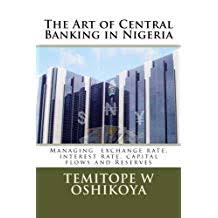An Excerpt from “The Art of Central Banking in Nigeria” by Temitope Oshikoya
Image Credit: Amazon.co.uk
The unholy trinity or monetary policy trilemma states that a country can only choose two combinations of exchange rate stability, monetary independence and open capital mobility. This means that a country can only make two possible combination of choices among exchange rate stability, monetary independence and open capital. This can be examined in two scenerios below:
1. When a country operates fixed exchange rate (stable exchange rate), then there will be automatic capital mobility into the country because of running an open economy (aided by the fixed exchange rate). And when there is an automatic capital flow/mobility, it means the country cannot maintain an independent monetary policy. Here, what happens in the foreign exchange market influences monetary policy.
2. However, when there is free capital flows, then it leads to floating of the exchange rate to reflect changes in demand and supply. This is when the country can maintain an independent monetary policy. This means that monetary policy is independent on what happens in the foreign exchange market.
When considering the effectiveness of both fiscal and monetary policy, then the above can further be divided under 4 possible scenerios:
1. Under a combined zero capital mobility and a fixed exchange rate regime, both monetary and fiscal policies are rendered impotent.
2. With perfect capital mobility and a fixed exchange rate regime, monetary policy is still impotent, but fiscal policy multiplier is more effective.
3. With a zero capital mobility and a free floating exchange rate, both fiscal policy and monetary policy regains some potency. As the degree of capital mobility increases, fiscal policy multiplier increases.
4. With perfect capital mobility and a free floating exchange rate regime, monetary policy is more effective while fiscal policy is rendered ineffective. As the degree of capital mobility increases with flexible exchange rate regime, fiscal policy multiplier declines while that of monetary policy increases.
Dr, Temitope Oshikoya examined the evolution of the trilemma indices in the context of the exchange rate, interest rate and capital controls management framework in Nigeria from 1960 to 2014.
During the 1960-1985 period, Nigeria practiced closed capital mobility, fixed exchange rate and intermediate monetary independence. The preference of the then CBN governor was monetary independence and exchange rate stability. As such, the country could not experience an open capital mobility.
The period 1986 to 2014 saw Nigeria move from closed capital mobility into open capital mobility. As such, the exchange rate was less stable (a flexible exchange rate regime was adopted) and there was more monetary independence.
According to Dr. Temitope Oshikoya, from 2020 upwards will see Nigeria move towards open capital mobility, exchange rate stability and loss of monetary independence.
For more empirical knowledge about the unholy trinity, you can pick up “The art of Central Banking in Nigeria” from Amazon.com, CreateSpace.com, and other retail outlets.
Related Articles
1. Nigeria’s Corruption Perception Index (1996-2018)
2. Significant Relationship among the Components of a Misery Index: The Nigerian Scenario
3. Sesame Seed as a Nigerian Cash Crop- An Unsung Hero
4. Simple Analysis of ORide’s Business Model
5. Analyzing Time Series Data Using Eviews: A case for Single Equation
6. Using Excel for Data Analysis
